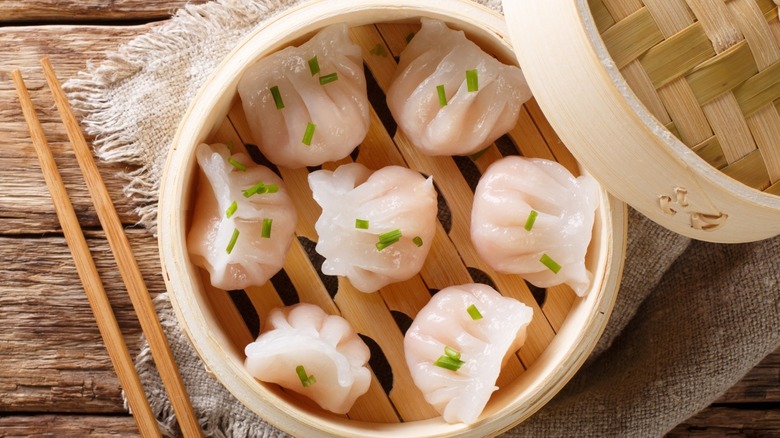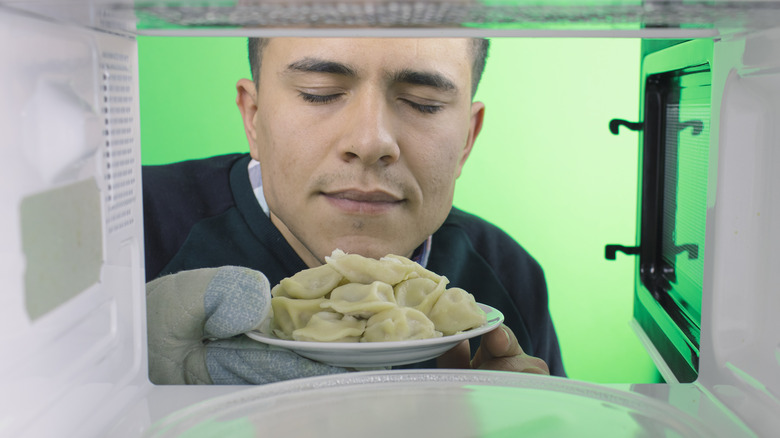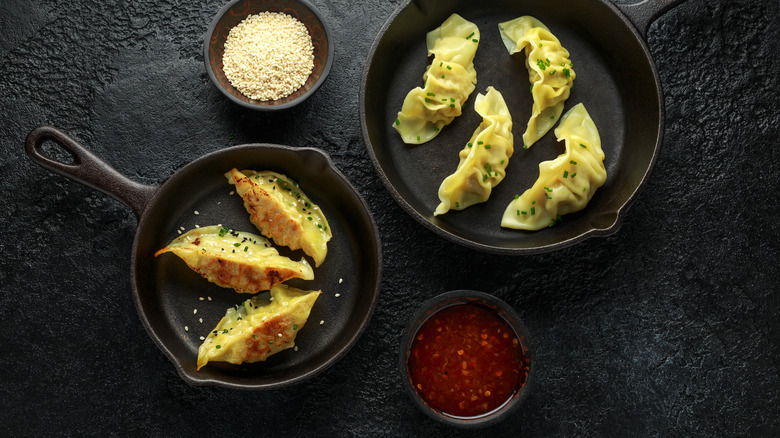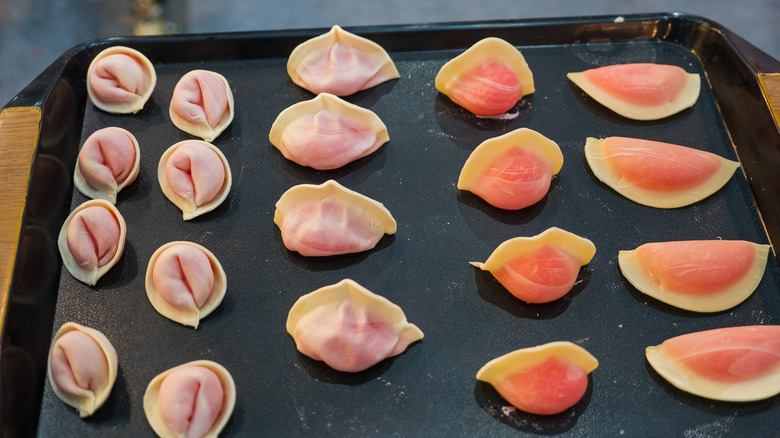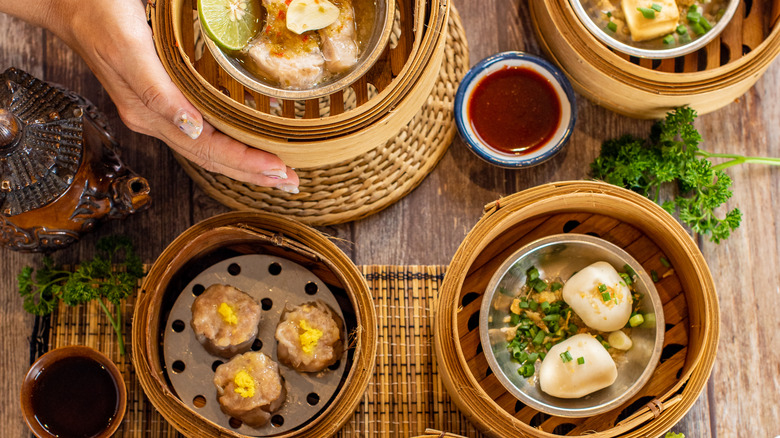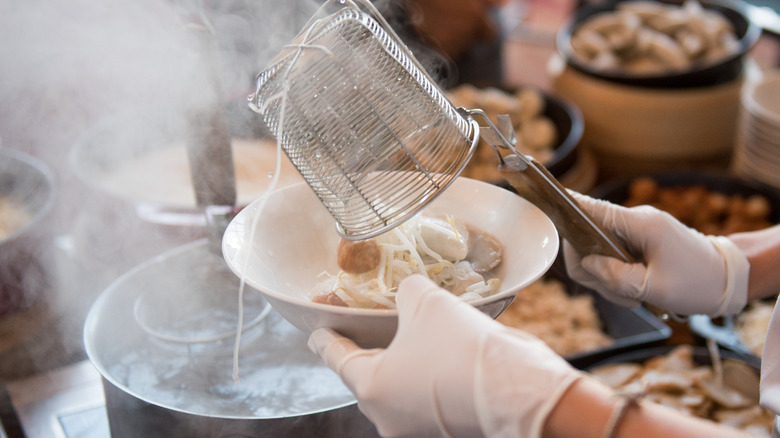You've Been Reheating Dumplings Wrong Your Whole Life
Awwww dumplings. Those little magical pockets of glistening pasta filled with a milage of savory meats, cheeses, and veggies. They are as intriguing as they are delightful to eat and many countries have their own culturally relevant versions of them. Everyone has their favorite, whether talking about tortellini or ravioli from Italy, South American empanadas, Eastern European piroshki, and pierogi, or Asian potstickers, momos, and gyoza, they are a truly universal cuisine that is beloved by many (via History).
The Asian version of the dumpling is more popular than ever and has become as ubiquitous to the American consumer as hotdogs, hamburgers, and apple pie. There's is no need to venture off to Chinatown to get your dumpling fix. They can easily be found in local take-a-way eateries, chain restaurants, ordered online via food delivery apps, and of course, in the frozen food aisle of your local supermarket.
Here is everything you need to know about reheating and cooking Asian dumplings so that you get them right every time you are ready to chow down.
Microwaving with a mug of water
Before you dismiss this cooking technique, consider the omnipresent power of the microwave for reheating dumplings. Safe, simple, and easy for the most novice of home cooks, this is the quickest way to get those luscious dumplings from the freezer to the plate. Because the microwave cooks food from the inside out, you will be consistently treated to a moist and delectable dumpling that is almost impossible to mess up.
Microwave Prep suggests placing fully cooked, frozen dumplings in a microwave-safe bowl covered with a damp paper towel. Simply set the timer for two or three minutes (based on how many dumplings you are cooking) and nuke on high power. The result is a hot and steamy dumpling that maintains its moisture without leaching any of its flavors. Serve with hot chili oil or teriyaki dipping sauce, and it is sure to be a real crowd-pleaser.
Heating in a skillet
If soft, pillowy dumplings with a moist center and caramelized crispy crust are what your craving, then your reheating utensil of choice should be a skillet. For the best results possible, we recommend cast iron flat pans or skillets, and caution against the use of non-stick pans. Restaurateur David Dresner had this to say in an interview with St. Louis magazine, "They're called potstickers because they stick to the pot, so don't fight it by using a non-stick pan. Teflon has its place. Potstickers isn't it."
Use enough high smoke point vegetable oil to cover the bottom of the pan and brown them slightly on each side until they are crispy and warm all the way through, or you can fill the pan up with oil and deep fry them until they form a crispy, bubbly crust. The choice is up to you. Dressner went on to say, "What's the best way to eat a potsticker? In my opinion, with your hands. Touching food with your hands creates trust. It builds a relationship. You can discern the texture and see if it's too hot or too cold."
Baking in the oven
If quick and easy is a priority, then try reheating dumplings in the oven. Foods Guy recommends this process because it allows the dumplings to get crispy without sacrificing any of the moistness inside or allowing the dumplings to get too greasy or oily as they can sometimes can when deep-fried. Simply place evenly spaced pre-cooked dumplings on a shallow baking dish that has been pre-lined with aluminum foil or dabbed with a vegetable oil-soaked paper towel to keep them from sticking to the pan. Cook in a medium heat oven for about five minutes and then, voila! You are treated to potsticker perfection that can proudly be served to friends and family. Cool before serving and add a bit of freshly chopped green onions or scallion along with a dipping sauce and you are in for a treat. When speaking with NPR, executive chef Scott Drewno from The Source by Wolfgang Puck in Washington, D.C., said it best," They're everything you want in a dish — salty, savory, filling."
Steaming in a basket
When it comes to reheating dumplings, especially Asian potstickers or gyoza, the traditional way is always the best, and that is by steaming. This process yields tried and time-tested results that give way to sumptuous dumplings that are never too oily, waterlogged, or soggy. You can opt for either metal or bamboo steamers, but the latter is the traditional choice from Asia. Bamboo steamers yield numerous benefits, including the ability to serve your dumplings steaming hot in the basket for an extra level of presentation.
Cynthia Chen McTernan, author of the cookbook "A Common Table," shared this, "Dumplings are one of those things that are supposed to represent heralding prosperity. But the other wonderful thing about them is that they're so communal to make together. You can all sit around the table, and beyond eating together, you can make it together." In an accompanying recipe, it is noted that potstickers should be steamed (via National Post).
Boiling in hot water
When it comes to dumplings, the most intuitive and basic preparation that is universally accepted is probably boiling in hot water. Find a pot, fill it up with water and a dash of salt, bring to a roiling bubble and dump your frozen potstickers in there while waiting anxiously for them to float to the top without splitting and losing any of their precious fillings.
Yet there are some hacks you can utilize to take the tasty treats to the next level. Food & Wine suggests boiling briefly. After reheating for just a few minutes in water, be sure to fish your potstickers out individually with a slotted spoon. Next, place them in a single layer on a plate or tray so that they do not absorb too much water and fall apart. And finally, fill a couple of dipper cups with your favorite sauces and enjoy.
